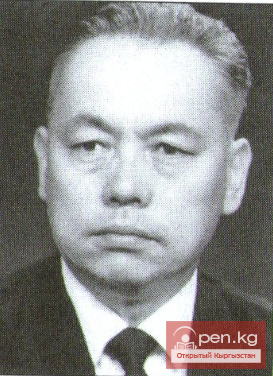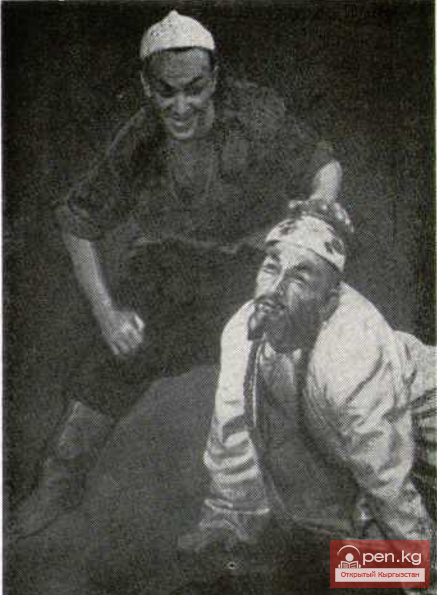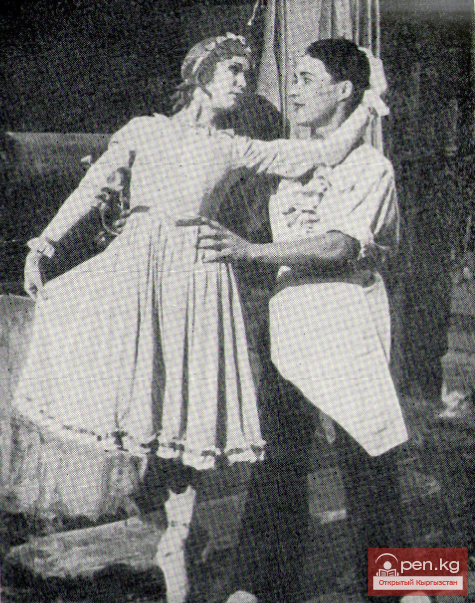
The Dance in Kyrgyz Opera is a Convincing Addition.
An example of the organic integration of dance into the action is represented by the opera "Toktogul" by A. Maldybaev and M. Abdrayev (1956).
... People are working to construct a canal and bring water to the fields. But the horsemen of Kerimbai are vigilantly watching to ensure that the water does not reach the people. At this moment, Toktogul appears. The people greet him with enthusiasm, and the dance (accompanied by a choir) expresses the joy of meeting the akyn.
The second dance has a different character. Toktogul is returning from exile. He must be informed of the death of his beloved son.
But no one dares to tell him. Then a narrative dance begins. It conveys to Toktogul the sad news of the death of his son Topchubai. In the music, a variation of Toktogul's farewell to his son before sending him into exile is repeated, but now it is filled with unfamiliar, anxious rhythms. And the sensitive-hearted Toktogul sensed the anxiety that the music and dance carried to him.
In the final part of the opera, there is a mass jubilant dance that conveys the joyful uplift in the people.
The opera by A. Maldybaev and M. Abdrayev did not remain in the repertoire, and a more perfected version of the opera about the great Kyrgyz akyn was later created by composers A. Maldybaev, V. Vlasov, and V. Fere (libretto by J. Bokonbaev and K. Malikov). The opera was performed in Moscow during the decade of Kyrgyz art and literature in 1958. Its original title was "The Singer of the People - Toktogul," but later it, like the previous ones, was renamed "Toktogul."
Among all the operatic works about the great Kyrgyz akyn, there is much in common. First of all, it should be noted that in the opera by A. Maldybaev, V. Vlasov, and V. Fere, there is a dance of the horsemen of Kerimbai in the second act. It is preceded by a signal from the karnaevs, as if calling out: "Look, everyone!" The dance was meant to express the strength and power of Kerimbai.
Based on the folk melody "Terme Kambarqan," the dance of the horsemen was characterized by heaviness. In the same scene, there is another dance. It contrasts with the first one — it is light and cheerful, accompanied by the melody of the Toktogul song "Kerbez" — lively and satirically sharp.
The epilogue of the opera shifts the action to the Soviet era. Despite some conventionality of the epilogue, it expressively captures the optimistic worldview that runs throughout the entire performance. It finds its concrete embodiment in dances painted in bright tones. Here, sparkling dances in the tempo of the tarantella are replaced by folk dances reminiscent of Toktogul's "Kerbez," culminating in a collective celebration.
The operatic performance "Oldjobai and Kishimjan" by composer Mukash Abdrayev also contains a number of dances. In the first act, the youth gathered on the lawn initiate games in the spirit of the traditional "Selkin-chek." The popular game "Jooluk Tyshtamay" and witty couplets create an atmosphere of immediacy. The game, conducted not without cunning, ends with a paired dance of young men and women. This peculiar introduction sets the tone for the subsequent pathos of pure love expressed in the performance.
In the second act, during the wedding scene, a true dance festival occurs, full of joy.
The men begin. Then the dance becomes collective. It is accompanied by a humorous melody played by Sh. Termechikov.
Kyrgyz music is replaced by a melodic Uyghur melody, and two pairs in national costumes perform the Uyghur dance. Once again, a Kyrgyz melody sounds. This time, the kyui "Ak Nooda" ("White Branch"), widely spread in Southern Kyrgyzstan, is heard, and the lively dance captivates everyone. The dances in the opera are characterized by a zest for life and emotional color.
One of the last national operatic performances is "Manas" by composers V. Vlasov, A. Maldybaev, and V. Fere, which revives the pages of the heroic past of the Kyrgyz people. First shown on the stage of the opera theater twenty years ago (in 1946), the performance has now been restaged. According to the choreographer K. Mademilova, the dances are meant to emphasize the opposing nature of the two antagonistic forces embodied in the images of Manas and Konurbai.
The choreography in the scene occurring in Konurbai's camp is unique in its content. The dance breaks down into several episodes, but all of them form a cohesive whole and serve to characterize both Konurbai himself and his entourage. Everything that the khan's horsemen do eloquently reveals the characters of coarse and cruel people. But then the captives enter the dance. Their variations express meekness, fear, and at the same time a plea for freedom. The horsemen reappear. The dance becomes collective. The cynicism and debauchery of the khan's lackeys reach a climax in the episode of their revelry, mocking the captives.
The choreographer's successfully found means of artistic expressiveness in dance deepen the social characterization of the enemy.
The second group of dances in the opera is linked to the action in Manas's camp. Guests arrive at the hero's place, and a dance with a choir — "Kyrk Choro" ("Forty Choro") begins. This dance of Manas's closest companions demonstrates agility and strength while simultaneously expressing hospitality towards the guests. The following dances of the guests (Indian, Mongolian, Persian) are imbued with a sense of respect for Manas and his companions. The choreographer managed to reflect the national specificity of the guests' dances. Thus, in the Indian dance, K. Mademilova drew from the characteristic features that distinguish the slow ritual movements of the faithful. The Mongolian dance reproduced elements of national wrestling. The Persian dance is filled with Eastern languor and refined plasticity.
Dances in such an epic performance as "Manas" are a convincing addition to the action, enriching the operatic spectacle.
It must be acknowledged that dance in opera has often occupied a rather modest place. Nevertheless, in most cases, it should be regarded as an organic component of Kyrgyz opera.
In our time, from opera to opera, from one ballet performance to another, the mastery of dance is being perfected, spreading among the masses an example of beauty in art and life.
National Operatic Performances in the Repertoire of the Kyrgyz Opera and Ballet Theater













































